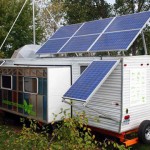(Via Inhabitat) Which may, in fact, exceed FEMA’s exertions – despite the fact that, as Paul Villinski, a  New York-based artist has demonstrated, it’s entirely possible to construct livable/usable emergency structures which rely on solar and wind power. From Bridget Steffen at Inhabitat, Solar Powered Mobile Emergency Response Studio:
New York-based artist has demonstrated, it’s entirely possible to construct livable/usable emergency structures which rely on solar and wind power. From Bridget Steffen at Inhabitat, Solar Powered Mobile Emergency Response Studio:
Better yet, make sure you read the whole piece and see the images – the one above the jump, taken alone, doesn’t do it justice.NB: as of this writing – October 30th – Villinski’s bandwidth limit had been exceeded. Waiting and checking back later will, we think, be worth it.